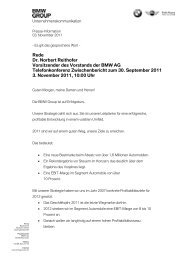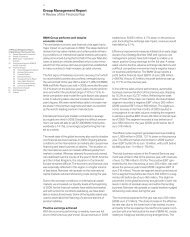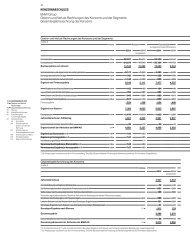Article by Prof. Dr. Hans Hunfeld (PDF, 151 KB). - BMW Group
Article by Prof. Dr. Hans Hunfeld (PDF, 151 KB). - BMW Group
Article by Prof. Dr. Hans Hunfeld (PDF, 151 KB). - BMW Group
You also want an ePaper? Increase the reach of your titles
YUMPU automatically turns print PDFs into web optimized ePapers that Google loves.
2.4 Finding the “foreign” in what is one’s own<br />
The foreign has first of all to be (re-)discovered in the familiar. That one’s own language has<br />
been formed <strong>by</strong> “foreign” elements is demonstrated not only <strong>by</strong> foreign words but also in<br />
those parts of the language whose foreign origin is covered up as these elements have<br />
become part of one’s own culture (names, terms , conventions). Such discoveries show the<br />
naïveté of those modes of understanding which rely – due to their lack of knowledge – on<br />
what is one’s “own” (as the authentic yardstick). The ease with which e.g. the youth culture<br />
appropriates the “foreign” (anglicisms, use of English) shows the normalcy of foreign<br />
influences.<br />
2.5 Expectations and attitudes<br />
The authentic expression of the foreign other can contradict one’s own wellintentioned<br />
expectations. Thus, folks songs, myths and fairy tales might conserve certain images and<br />
interpretations which no longer correspond to the reality of the contemporary foreign culture.<br />
The intercultural dialogue is likely to be impeded <strong>by</strong> such a mode of engagement with a<br />
foreign culture. The example of the tourist who perceives abroad, above all, the exotic, and<br />
not the complexity and contradictory reality of a foreign culture, serves as a warning to all,<br />
particularly to those who teach, to be alert to their own prejudices. This caution is further<br />
enhanced <strong>by</strong> the paradoxical experience that travelers from highly industrialized nations<br />
blame the very cultures in foreign lands for the disappearance of the exotic idyl, while at the<br />
same time loudly bemoaning the lack of progress in these societies. Similar attitudes are<br />
expressed vis-à-vis the foreigner among us, e.g. when he or she is expected to behave in a<br />
fashion which is derived from some stereotype of the foreigner and not from the engagement<br />
with him or her as a person.<br />
2.6 Perspectives<br />
Intercultural learning makes transparent – whatever the themes, questions, or phenomena<br />
might be which give rise to it – above everything else the perspectival character of the world.<br />
It protects us from the homogenization of these differences and their absorption into the<br />
seemingly similar. Elemental forms and conditions of human existence (earth, fire, water,<br />
air), perceptual categorizations (time, space, directions) and their particular employment<br />
in different cultural contexts are the first occasions and triggers for learning. For example,<br />
rain, heat, or frost are, even within Europe, differently perceived and have different levels of<br />
importance. Similarly, East and West have culturespecific connotations, and “left” and “right”<br />
are (again) fraught with specific cultural meanings. The clearer these elementary distinctions<br />
are brought out and the more explicit their farreaching implications are made, the more our<br />
insight concerning the normalcy of differences as well as the relativity of one’s own normalcy<br />
is enhanced. Familiar meanings of colors when confronted with other strange interpretations<br />
provide further examples and thus an opportunity (of course not the only one) for making<br />
this point. For an effective intercultural dialogue it is crucially important that such different<br />
interpretations can be genuinely discussed and that they are listened to with an open mind<br />
and with curiosity.<br />
2.7 The “third culture”<br />
It cannot be the goal of intercultural learning to give up one’s own culture, to exchange it<br />
for the “foreign other”, or to get lost in a diffuse and uncritical multiculturalism. Intercultural<br />
learning leads, however, from the elemental step of distancing oneself from what is one’s<br />
own, via approaching the “foreign other” through understanding, to a characteristic position<br />
“in between” which has been called the “third culture”. 18 Taking this position lets us


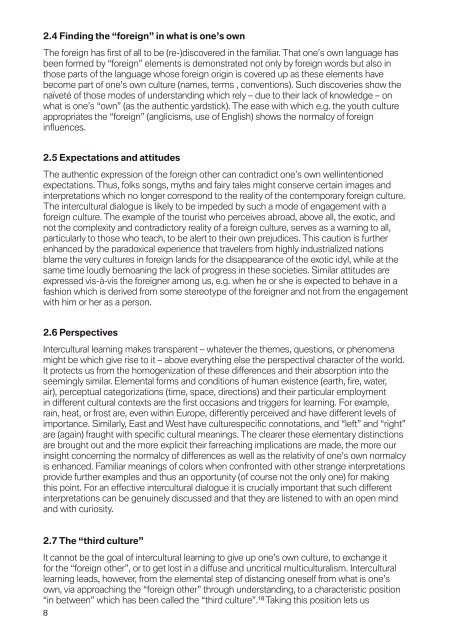




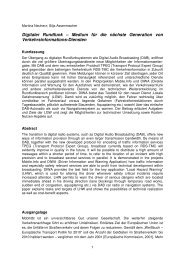



![Vollständiger Bericht [PDF] - BMW Group](https://img.yumpu.com/20706531/1/190x238/vollstandiger-bericht-pdf-bmw-group.jpg?quality=85)
